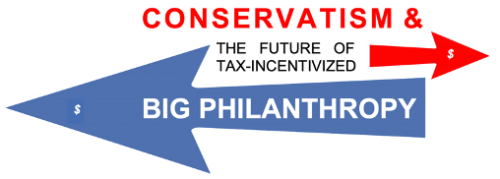Improve lives, grow and strengthen civil society, and demonstrate the power of private giving based on our core values.
Part of The Giving Review’s online symposium, “Conservatism and the Future of Tax-Incentivized Big Philanthropy.”
It is certainly true that, as The Giving Review has noted, private philanthropy in the United States “is increasingly on the defensive.” Whether such a position is justified, however, is a subject of debate. American philanthropy has a long and distinctive heritage, but it is no stranger to controversy. Anyone familiar with John Rockefeller’s struggle to obtain a federal charter for the Rockefeller Foundation (first funded by the donor in 1909 when philanthropy was not yet “tax-incentivized”) knows that his opponents characterized such an institution as an enemy of democracy. The federal charter never materialized, but with a New York State charter in hand, Rockefeller went on to build a legacy of private giving that continues to this day.
As the number and size of private foundations increased through the 20th and early 21st Centuries, concerns about these vehicles continued, always with the question of whether donor-directed philanthropy was actually focused on the “public good,” a term that defies an unbiased definition. Rules and regulations followed to stem activities that were deemed political, mandate an annual payout, prohibit self-dealing, and require tax filings that included transparency around compensation, grantmaking, and investment management. Yet despite the complex compliance demanded by IRS overseers, Senate Finance Committee Chairman Chuck Grassley opened a set of 2004 hearings on the nonprofit sector (charities and foundations alike) by complaining, ''Big money, tax free, and no oversight have created a cesspool in too many cases.''
Facing its critics, the philanthropic sector has never denied that abuses occur, nor has it opposed reasonable regulations. But the dialogue about philanthropy has changed over the past five years or so, and unlike my colleagues at The Giving Review, I am concerned that a conservative nod to new regulatory mandates based on someone’s opinion of “what Big Philanthropy is doing in, and to, America” will have a disastrous impact on philanthropic freedom, on private giving, and on civil society.
Three books published in 2018 questioned the legitimacy—even the very premise—of private philanthropy in the United States. In Just Giving, Stanford University professor Rob Reich, who had once viewed even “big” philanthropy as a counterweight to big government and big business, questioned whether tax-advantaged private philanthropy was simply power exercised willfully and without public accountability, a force that might undermine democracy. Winners Take All became the platform through which former McKinsey consultant Anand Giridharadas questioned the motives and the efficacy of philanthropists who, he alleged, used their giving to avoid confronting how they came by their power and wealth. Edgar Villanueva’s Decolonizing Wealth explored the relationship among racism, an extractive economy, and wealth creation, and called for increased power-sharing and greater equity in philanthropic decision-making.
With those three books as a backdrop, private philanthropy faced the 2020 challenges of responding to a national health crisis, lockdowns, ensuing economic and educational crises, and a simultaneous racial upheaval. The response was overwhelming from small and large foundations that represented a wide spectrum of philosophical persuasions. Beyond providing additional funding that year, foundations changed their grantmaking operations. They eliminated or streamlined applications and reporting requirements, fast-tracked the approval process, used electronic transfers for quicker payments, redirected project-specific grants to general operating support, and removed challenge or matching requirements. Nonetheless, the doubters and critics of philanthropy continued to demand more. In that tumultuous year, a group calling itself Patriotic Millionaires pushed Congress to double the minimum share of assets foundations would be mandated to distribute. One of their spokespersons, Scott Wallace of the Wallace Global Fund, remarked that “only Congress has the power to force this massive injection of wealthy people’s money into jobs and nonprofit charitable organizations working in vital areas like health care, food banks, poverty alleviation, education, social justice, and economic development and job creation.”
In response, I suggested that it was hardly “patriotic” to interfere with the decisions of foundation boards—the rightful stewards of their endowments—regarding foundation payout or lifespan, or to mandate that they abandon their values, missions, or donor intent in their grantmaking. Instead, we should allow foundation governance to work and produce a healthy variety of voluntary responses. And foundations did, in fact, differ in their responses to increased need, with some immediately ramping up their giving overall and others sticking with their typical annual payout while refocusing some dollars on health or on economic issues resulting from the lockdowns.
But there is a more important lesson here. All too frequently, the advocates of what appear to be simple, structural changes to philanthropy are seeking to destroy what Karl Zinsmeister once called “a riotous patchwork” of private giving choices in order to drive all philanthropy to their own notions of the what-should-be-obvious central problems of American society. Conservatives should be wary of what’s behind the curtain and protect
the broad range of causes and organizations funded by nongovernmental dollars, the increasing number of ways donors can deliver those dollars, and the many timetables on which those dollars are expended [which] all make for a vibrant civil society that is nimbly responsive, deliberately experimental, and determinedly focused all at the same time.
Conservatives should also reject the premise behind many of the “reforms” currently suggested for both private foundations and donor-advised funds (DAFs) that tax incentives designed to grow giving and protect civil-society institutions from unreasonable government control are actually subsidies that transform dollars privately donated into assets that belong to the public and are therefore subject to democratic control. This claim has been successfully rebutted, most notably by Evelyn Brody and John Tyler in their publication, How Public is Private Philanthropy? We should be clear in our acknowledgment that the state has the authority to regulate and supervise all §501(c)(3) entities to ensure that their assets are not used for private benefit. Beyond that, however, tax incentives do not oblige private foundations and other charities to use their assets to serve the same ends as government. “Autonomy has been one of the defining characteristics of American foundations and other charities,” Brody and Tyler concluded. “Such entities are free to support and pursue differing and even contrary programmatic visions, strategies, methods, and structures provided that they do not stray from their mandate to serve charitable purposes.”
We should also acknowledge that the Internal Revenue Service definition of “charitable purposes” covers a multitude of causes that may not appeal to Americans of one political persuasion or another. I find it quite ironic, for example, that the Hewlett and Ford Foundations and the Omidyar Network are utilizing their charitable resources to replace “the neoliberal paradigm” that liberty and prosperity are best achieved with limited government in a free-market system when their assets originated from the disruptive innovation that flourishes in that very system. Many conservative outlets—including The Giving Review—have also expressed their unhappiness with the grantmaking of the multi-billion-dollar Ford Foundation, and with CEO Darren Walker’s advocacy of moving “from generosity to justice.” As two of its co-editors noted, “Whether Big Philanthropy’s power is in the hands of detached professionals or radical activists, it is very far from what everyday American citizens have in mind when they think of charitable activity.”
While I understand this concern, the distinction between philanthropy and charity is not new; the search for root causes engaged John Rockefeller throughout his life. Today, foundations of all sizes and philosophical persuasions frequently supplement their support for basic community needs with grants to support research or policy-focused nonprofit organizations. We see this in admittedly conservative grantmakers like the Bradley Foundation, which blends its support of faith-based, human service and arts organizations in Milwaukee with its grants to “advance federalism and limit government at the national, state, and local levels.” And we see it in progressive funders like the Park Foundation, which combines grants “dedicated to advancing a more just, equitable and sustainable society” with support for human service and cultural nonprofits in its home community of Ithaca.
Finally, any attempt to define “Big Philanthropy” will be fraught with challenges. Sen. J. D. Vance seems to have decided that $100 million is the magic number, suggesting that foundations with more than that amount in assets be required to pay out 20% each year or else lose their tax-exempt status. That is, in essence, a mandatory death sentence for a broad swath of foundations in this country. And even if there were agreement on a significantly higher number, does it make any sense to demand that foundations that, in Vance’s words, constitute “a massive left-wing bias at the heart of our society” flood civil society with even more progressive dollars?
As I noted in a RealClearPolicy article,
It’s essential that those who seek to kneecap philanthropic generosity on ideological and political grounds remember what goes around comes around. Ill-conceived government mandates will not discriminate—nor should they. Additional regulations will not just burden the foundations politicians or bureaucrats dislike, but all foundations governed by the same rules.
It's likely that any new regulations would have a far greater negative impact on small and regional organizations than “big” ones and reduce the amount of charitable dollars available to those in need.
We should also recognize that that limiting foundation and DAF lifespans and adjusting payout rules will never satisfy the hard-core opponents of philanthropy, those who maintain that wealth itself is the problem and that confiscatory taxes and expanded government spending are the solutions. In the process of attempting to appease them, conservatives will sacrifice both donor intent and donor privacy, essential elements of philanthropic freedom.
Instead, conservatives should forgo the use of government mandates and work to change philanthropy through the optimism and excellent grantmaking that was so evident in the last quarter of the previous century. We can encourage and assist conservative donors to commit to the long term and build new institutions where none exist or where existing ones have grown bloated and stale; to defend and advance our nation’s constitutional principles; to restore democratic norms, including free speech and religious freedom; to promote limited government and voluntary association; to expand economic opportunity within the free market; to strengthen families and communities; to build character and reinforce the value of personal responsibility; and to stand up for individual rights and the equality of all people.
That is how we improve lives, grow and strengthen civil society, and demonstrate the power of private giving based on our core values. Our success—and the strength and resilience it will bring to our communities—is how we can meet the challenge of so-called “Big Philanthropy.”






